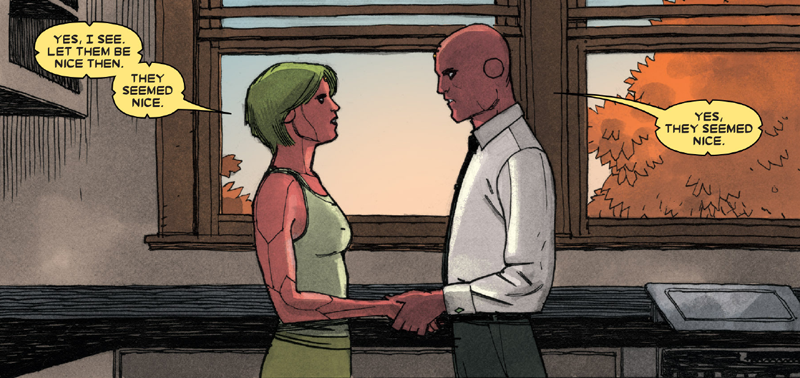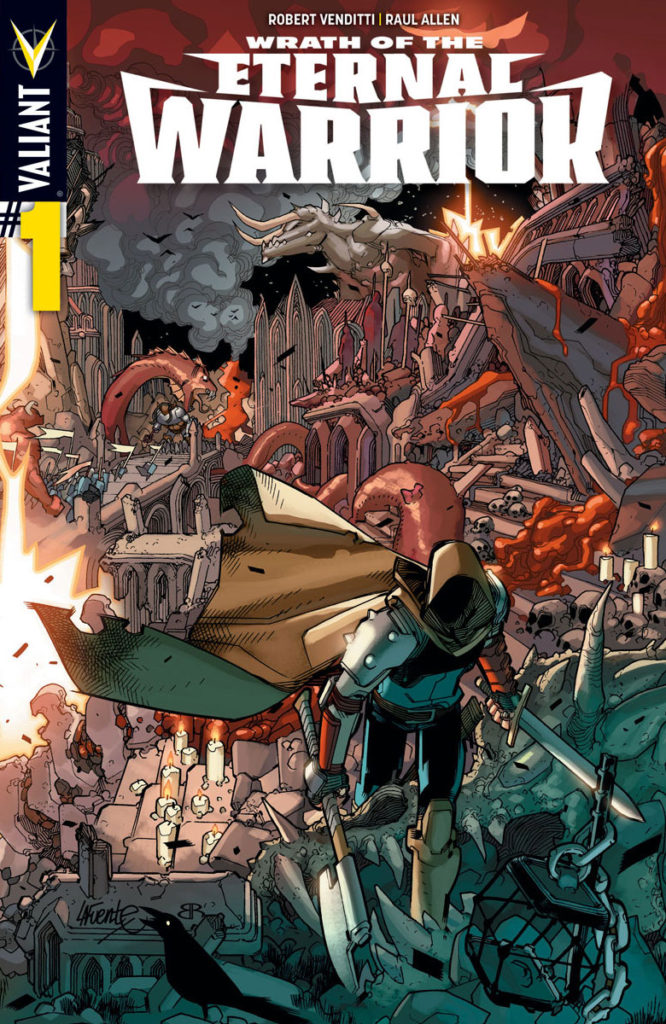
The holidays are here, which means it’s a prime time for comic fans to dive into the books we love, both old and new. And if you’re still unsure of which ones to ask for for Christmas and binge-read, you’re in luck. While it’s impossible for me to stay on top of every book in the DC, Marvel and independent scene, I’ve nonetheless compiled a list of five titles I’ve recently read, and which I believe are well-worth your time.

1) Jupiter’s Legacy/Jupiter’s Circle (Image): Mark Millar’s creator-owned superhero saga has garnered mixed response since its debut in 2013. Some really enjoy the main series Jupiter’s Legacy, but are less enthusiastic about its prequel Jupiter’s Circle. I personally love both, and would rank it in my top three books from the Millarworld line. Legacy tells the story of the children of the superhero couple the Utopian and Lady Liberty (who are the Superman and Wonder Woman of this universe), and how their struggle to live up to their parents’ legacy leads to their rebellious nature. Subsequently, the book explores the Utopian’s rivalry with his metahuman brother, and how his power begins to crumble in the modern world.
Circle takes place in the 50s and 60s, sometime after the heroes discover their powers on a mystical island. Whereas Legacy exhibits Millar’s trademark blockbuster storytelling approach, Circle is more a series of interconnected short stories about each of the team member’s personal lives. Unlike the ideal moral figures they’re thought of as, here we see them behind the scenes committing adultery, betraying each other, and possessing views contrary to traditional American capitalism. Also there is a central plot point throughout the whole story involving a team member who eventually turns rogue, an event which is referenced in Legacy.
The main drawback for some readers is that legendary artist Frank Quitely illustrates Legacy but not Circle. Much like Alex Ross, Quitely is the kind of artist who needs extensive time in order to provide the amount of detail and precision in his pencils, so it’s understandable that he couldn’t commit to both books in this series. Nevertheless, the art by Wilfredo Torres in Circle is still pretty stellar and coincides perfectly with the book’s Silver Age influence. The Jupiter saga does take obvious inspiration from Watchmen, Kingdom Come, The Incredibles and other iconic superhero epics, but there’s still enough new material in it to make it stand on its own. If you’re a fan of Millar and aren’t turned off by a significant amount of political themes, I think you’ll enjoy this one.

2) Mother Panic (DC’s Young Animal): While DC’s Rebirth line is still going strong, the publisher’s newest imprint Young Animal has already put out some great and delightfully weird comics. Spearheaded by My Chemical Romance lead-singer and The Umbrella Academy writer Gerard Way, Young Animal is in essence the spiritual sibling to the Vertigo imprint. In addition to rebooting old properties like Doom Patrol and Cave Carson Has a Cybernetic Eye, Way and company have also introduced entirely new characters like Violet Paige, A.K.A. Mother Panic.
Mother Panic tells the story of a celebrity heiress by day, and a brutal Gotham City vigilante by night. With her childhood marked by tragedy and her vigilante counterpart rooted in a gothic decor, Violet Paige is who Bruce Wayne would be if he were an anarchist. The first issue even features her yelling “F%%k the Bat” when asked if she had a connection to the Dark Knight. By the end of it you’re not sure whether or not to root for her, but that doesn’t make her story any less intriguing.
Written by Jodi Houser (Faith) and illustrated by Tommy Lee Edwards (Superman: American Alien), Mother Panic is a beautifully dark and psychedelic comic which you really don’t want to miss.

3) The Vision (Marvel): When I heard Marvel was giving the Vision his own series last year, I was intrigued and skeptical at the same time. Could this android character carry his own book without any of the other Avengers? Then I heard the premise, which was even more bizarre. The Vision was going to have his own artificially engineered family and live in the suburbs! I knew then that it would either flop or be a huge success.
Fortunately, all of my concerns were laid to rest when I finally got my hands on the first trade. I had heard the extensive praise for it, but man did this book blow me away. Writer Tom King and artist Gabriel Walta tell a truly mesmerizing story about artificial intelligence, prejudice, family and so much more. With its black humor, gorgeously dense art and genuine science fiction themes, there is nothing not to love about this comic. I have nothing else to say other than go pick up both trades right now and thank me later.

4) Wrath of the Eternal Warrior (Valiant): Robert Venditti’s stellar X-O Manowar run recently ended, but his other Valiant series Wrath of the Eternal Warrior is just as exciting an epic. Set as a sequel to the crossover miniseries Book of Death, this one follows Gilad as he’s trapped in a mysterious realm far from the one he knows on Earth. Desperate to return home, the mighty Eternal Warrior must face interdimensional threats unlike anything he’s encountered before.
No matter what book Venditti is writing, the man knows how to tell a story that’s both epic and character-driven. The battles here are bombastic, and the intimate scenes involving Gilad’s wife and kids are at times heartbreaking. And with an art team as dynamic as the one here, this is a comic every Valiant fan should read.

5) The Fade Out (Image): I’m fascinated by the era of classic Hollywood, so when you combine that with a comic book by some of the best creators in the industry then I’m already sold. Written by Ed Brubaker and illustrated by Sean Phillips, The Fade Out is a noir centered around the murder of a celebrity actress during the production of a major studio feature. Starring a pair of burnt-out screenwriters, one of whom is on the Hollywood blacklist for his communist affiliation, the book provides an in-depth look at this era and its sociohistorical influence.
Combining Brubaker’s spot-on dialogue and narrations with Phillips’s unique aesthetic and Elizabeth Breitweiser’s dense color palette, The Fade Out is an electrifying experience, particularly for film buffs like me. It’s like Double Indemnity meets Sunset Boulevard, in graphic novel form.
Those are my picks. What have you all been reading? Sound off in the comments below!